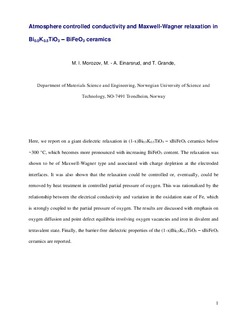| dc.contributor.author | Morozov, Maxim | |
| dc.contributor.author | Einarsrud, Mari-Ann | |
| dc.contributor.author | Grande, Tor | |
| dc.date.accessioned | 2014-11-24T13:40:56Z | |
| dc.date.accessioned | 2015-06-10T13:16:13Z | |
| dc.date.available | 2014-11-24T13:40:56Z | |
| dc.date.available | 2015-06-10T13:16:13Z | |
| dc.date.issued | 2014 | |
| dc.identifier.citation | Journal of Applied Physics 2014, 115 | nb_NO |
| dc.identifier.issn | 0021-8979 | |
| dc.identifier.uri | http://hdl.handle.net/11250/284879 | |
| dc.description.abstract | Here, we report on a giant dielectric relaxation in (1 x)Bi0.5K0.5TiO3—xBiFeO3 ceramics below
300 C, which becomes more pronounced with increasing BiFeO3 content. The relaxation was
shown to be of Maxwell-Wagner type and associated with charge depletion at the electroded
interfaces. It was also shown that the relaxation could be controlled or, eventually, removed by heat
treatment in controlled partial pressure of oxygen. This was rationalized by the relationship between
the electrical conductivity and variation in the oxidation state of Fe, which is strongly coupled to the
partial pressure of oxygen. The results are discussed with emphasis on oxygen diffusion and point
defect equilibria involving oxygen vacancies and iron in divalent and tetravalent state. Finally,
the barrier-free dielectric properties of the (1 x)Bi0.5K0.5TiO3—xBiFeO3 ceramics are reported. | nb_NO |
| dc.language.iso | eng | nb_NO |
| dc.publisher | American Institute of Physics (AIP) | nb_NO |
| dc.title | Atmosphere controlled conductivity and Maxwell-Wagner relaxation in Bi0.5K0.5TiO3 – BiFeO3 ceramics | nb_NO |
| dc.type | Journal article | nb_NO |
| dc.type | Peer reviewed | en_GB |
| dc.date.updated | 2014-11-24T13:40:56Z | |
| dc.source.volume | 115 | nb_NO |
| dc.source.journal | Journal of Applied Physics | nb_NO |
| dc.identifier.doi | 10.1063/1.4863798 | |
| dc.identifier.cristin | 1154699 | |
| dc.relation.project | Norges forskningsråd: 197497 | nb_NO |
| dc.description.localcode | This is the authors accepted and refereed manuscript to the article. (c) 2014 AIP Publishing LLC. | nb_NO |

